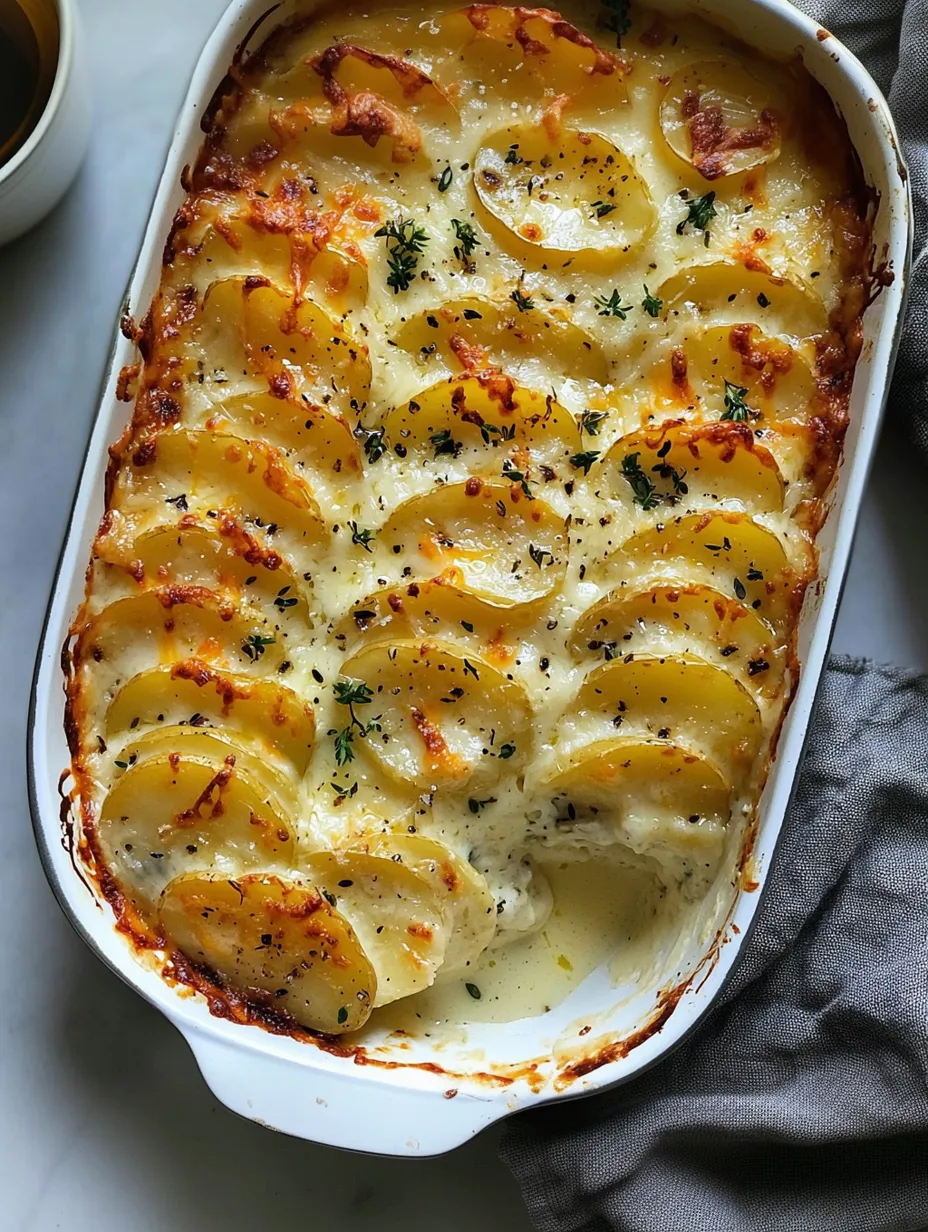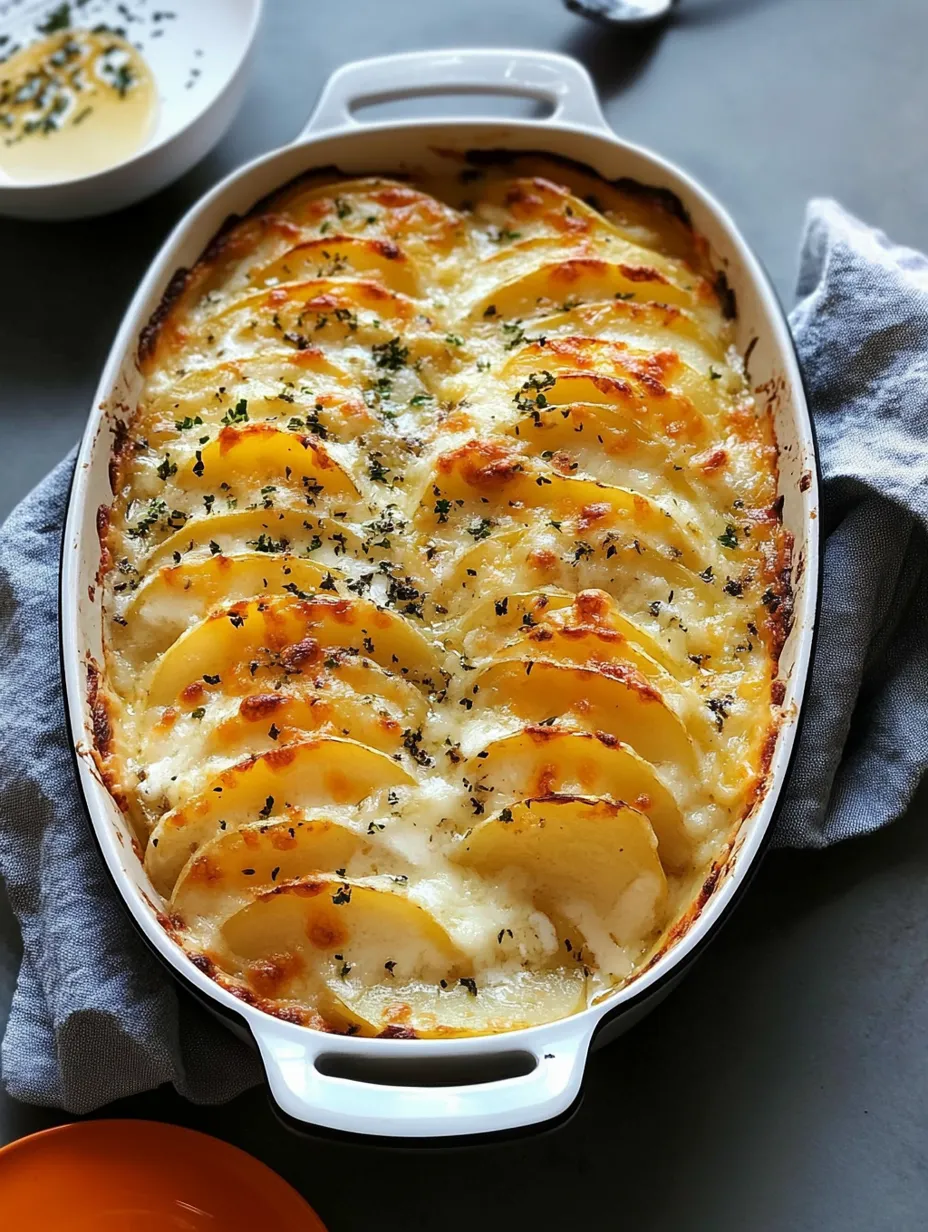 Pin it
Pin it
Creamy, cheesy potato heaven awaits anyone lucky enough to taste this spectacular side dish. I discovered this potatoes au gratin recipe years ago when attempting to recreate my grandmother's version that had everyone fighting for seconds at family gatherings. The combination of thinly sliced potatoes bathed in garlic-infused cream and two types of cheese creates something that transcends ordinary potato dishes. What makes this version special is the careful balance between creamy interior and crispy, golden exterior that develops during that final broil.
Why You'll Love This Recipe
- Creates that perfect balance of creamy inside and crispy topping
- Uses simple ingredients that transform into something extraordinary
- Makes enough to feed a crowd but scales down easily
- Elevates any main dish from casual weeknight meals to special occasions
- Delivers restaurant-quality results that will impress everyone
The first time I served this at a dinner party, my friend Beth - who claimed to be "watching her carbs" - helped herself to three servings and then asked for the recipe. Her husband joked that I'd ruined their diet plans for the week, but some dishes are simply worth the splurge. This has become my most requested recipe whenever I'm asked to bring a side dish somewhere.
Ingredients
- Russet potatoes create the perfect texture - their starch content helps thicken the cream sauce
- Uniform sizing helps ensure even cooking throughout the dish
- Peeling is essential for the silky texture we're aiming for
- Slicing paper-thin is crucial - a mandolin isn't just helpful, it's almost necessary
- Fresh potatoes without green spots or sprouts will give the cleanest flavor
My mother taught me to soak sliced potatoes in cold water to remove excess starch, but I've found that with this recipe, that extra starch actually helps create the perfect sauce consistency. The starch releases during baking and combines with the cream to create that luxurious texture that makes this dish so irresistible.
 Pin it
Pin it
Step-by-Step Instructions
- Perfect Preparation
- Preheat your oven thoroughly before beginning - temperature consistency is key to even cooking. Generously grease your baking dish with butter, making sure to cover the sides as well as the bottom to prevent sticking. When peeling potatoes, remove any dark spots or eyes completely. Use a mandolin set to the thinnest setting for perfectly uniform slices - this isn't just about appearance, it's about ensuring the potatoes cook evenly and absorb the cream mixture properly.
- Cream Infusion
- Combine the heavy cream, shredded white cheddar, Parmesan, and minced garlic in a bowl large enough to hold all your potato slices. The garlic should be very finely minced to distribute its flavor evenly without leaving large pieces. Add your potato slices directly to this mixture and use your hands to gently separate the slices and ensure each one gets coated completely. Don't rush this step - proper coating is essential for flavor development throughout the dish.
- Artful Arrangement
- Take small stacks of the cream-coated potato slices and arrange them vertically in your prepared baking dish, rather than laying them flat. This upright arrangement allows the cream to flow between the slices while baking and creates beautiful layers in the finished dish. Pack them tightly enough to stay upright but not so tightly that the cream can't circulate. Once all potatoes are arranged, pour any remaining cream mixture evenly over the top, allowing it to seep down between the slices.
- Baking Strategy
- Cover the dish tightly with foil for the first part of baking. This traps steam and helps cook the potatoes through without over-browning the top. When you remove the foil, the potatoes should be mostly tender but not completely done. Adding the final Parmesan at this stage creates that perfect crusty top layer as it finishes baking. The final brief broil is non-negotiable - it's what creates that irresistible golden brown crust that provides textural contrast to the creamy interior.
Cheese selection makes a significant difference in this recipe. I've experimented with dozens of variations over the years, and the combination of sharp white cheddar and Parmesan creates the perfect balance of creaminess and flavor. My aunt once substituted pre-shredded cheese from a bag and complained that her sauce broke and became greasy. The anti-caking agents in pre-packaged shredded cheese prevent it from melting properly, so always grate your own for the smoothest sauce.
Serving Suggestions
This potato dish partners beautifully with a simple roasted chicken or beef tenderloin for Sunday family dinners. For holiday meals, it holds its own alongside glazed ham or prime rib. The rich, creamy nature means it pairs best with proteins that have simple preparations rather than heavy sauces. Add a bright, acidic salad with vinaigrette dressing to balance the richness of the potatoes.
Flavorful Variations
Add caramelized onions between the potato layers for sweet depth. Substitute Gruyère for the cheddar for a more traditional French flavor profile. Incorporate fresh herbs like thyme or rosemary into the cream mixture for an aromatic twist. For a heartier version, layer thin slices of ham between the potatoes to create a complete one-dish meal. A pinch of nutmeg in the cream mixture adds subtle warmth that complements the cheese beautifully.
Storage Success
Store leftovers in the refrigerator, tightly covered, for up to three days. The potatoes will absorb more of the cream overnight, making them even more flavorful the next day. Reheat in a 325°F oven, covered with foil, until heated through - about 20 minutes. Avoid microwaving if possible, as it can make the potatoes mealy and the sauce separate. If freezing, do so before the final baking step, then thaw completely in the refrigerator before finishing in the oven.
 Pin it
Pin it
Chef's Wisdom
For extra insurance against curdling, bring cream to room temperature before mixing
Salting the potatoes adequately is crucial - taste the cream mixture before assembling
Using a wider, shallower dish creates more surface area for that desirable crispy top
Standing potatoes vertically creates more textural contrast than traditional layering
I've been making this dish for nearly every holiday gathering for the past decade, tweaking little details until reaching this perfection. The vertical arrangement was inspired by a French restaurant I visited in Montreal, where the presentation was so striking I immediately knew I needed to incorporate it into my version. What I love most about serving this dish is watching people's faces as they take that first bite - there's always this moment of surprise and delight when they realize these aren't just ordinary potatoes. Even potato skeptics find themselves reaching for seconds. It's become such a signature dish that family members now text me ahead of gatherings to make sure I'm bringing "the potatoes" - no further explanation needed.
Frequently Asked Questions
- → Can I make potatoes au gratin ahead of time?
- Yes! Assemble everything the day before, cover and refrigerate. When ready to bake, add 10-15 extra minutes to the covered baking time since you're starting with cold potatoes.
- → What's the difference between scalloped potatoes and au gratin?
- Traditional scalloped potatoes don't include cheese in the recipe, while potatoes au gratin always feature cheese. Au gratin also typically has a crusty, browned top.
- → Do I really need to use a mandolin?
- No, but it helps get uniformly thin slices which cook evenly. If using a knife, take your time to slice the potatoes as thinly and evenly as possible.
- → Can I use different cheeses?
- Absolutely! Gruyère is traditional and fantastic. Other good options include fontina, gouda, or even a sharp yellow cheddar. Mix and match to your taste.
- → Why are my potatoes still hard after baking?
- This usually happens if the slices are too thick or if the dish wasn't covered tightly during the first baking period. The foil traps steam which helps cook the potatoes.
- → Can I add other flavors to this recipe?
- Yes! Try adding fresh herbs like thyme or rosemary, a pinch of nutmeg, or even some caramelized onions between the potato layers.
